The tree or shrub known as Photinia Red Robin is a brilliant addition to the garden.
Not only is it evergreen, but the white flowers and bright red hues of the foliage in spring and summer provide a fabulous colour splash to borders.
Despite being evergreen, a small amount of leaf drop is normal.
If the plant is struggling however, large amounts of leaves can fall.
Red Robins have an open structure, so extensive leaf loss can leave bare stems.
So if you have asked the question “Why Is My Red Robin Tree Dropping Leaves?” then read on for answers and solutions.
2. Cold Weather
3. Not Enough Sun
4. Soil Type
5. Lack Of Magnesium
6. Too Much Water
7. Fungus – Leaf Spot And Armillaria Root Rot (Honey Fungus)
Dry Weather
Leaf drop in plants usually signifies a stress response.
In overly dry conditions Red Robin plants will drop their leaves to conserve water.
How to fix:
- If the weather is particularly warm and dry for prolonged periods, provide extra water for your Red Robin.
- Also provide extra water for recently moved plants, or young saplings, to help them get established.
- Mulch in spring to provide some extra organic matter and protection for the soil.
- This will also aid water retention through into the summer.
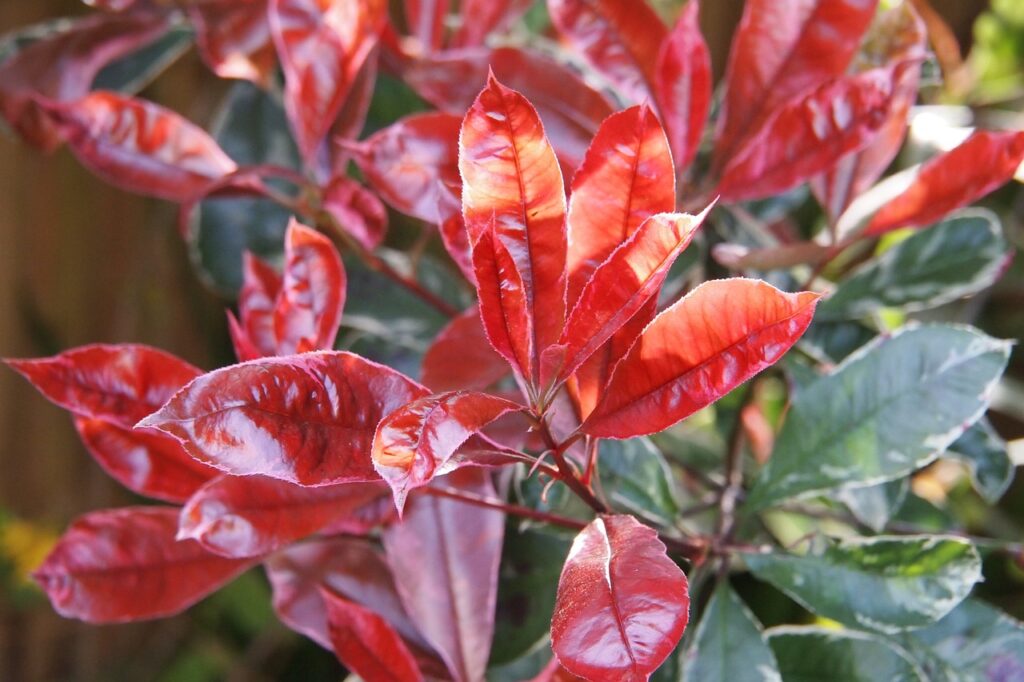
Cold Weather
Red Robins can also become stressed in very cold weather.
If the ground is frozen, the roots are not able to take up enough water to hydrate their leaves.
They will then leaf drop to conserve the water that they do have.
How to fix:
- Mulch in autumn to make sure the ground is able to retain water into the winter.
- This will also insulate the soil to some extent.
- If your Red Robin does shed it’s leaves during a cold winter – don’t worry, they should grow back in spring.
- To encourage new and bushier growth, wait until the new red leaves have turned green and then lightly prune the plant by removing one third of new growth, leaving two-thirds.
Not Enough Sun
Red Robins love the sun, and a sunny position encourages growth.
They ideally like six hours of sunshine as a minimum.
Red Robins will tolerate partial shade however you will find that the red leaf colour is less vibrant and growth is slower.
If a Red Robin is situated in full shade it may not flower, growth will be leggy and there may be more leaf drop than usual as the plant will be stressed due to insufficient light.
Shaded positions will also tend to be more damp, encouraging the growth of fungus.
How to fix:
- Never plant a Red Robin in the shade.
- If you have one situated in the shade then dig it up and relocate it in the early morning.
- This will retain the maximum amount of water in the plant and therefore hopefully minimise the transplantation shock.
- If it is impossible to move the Red Robin then keep the ground around the plant clear of debris.
- This will increase ventilation and minimise fungus growth.
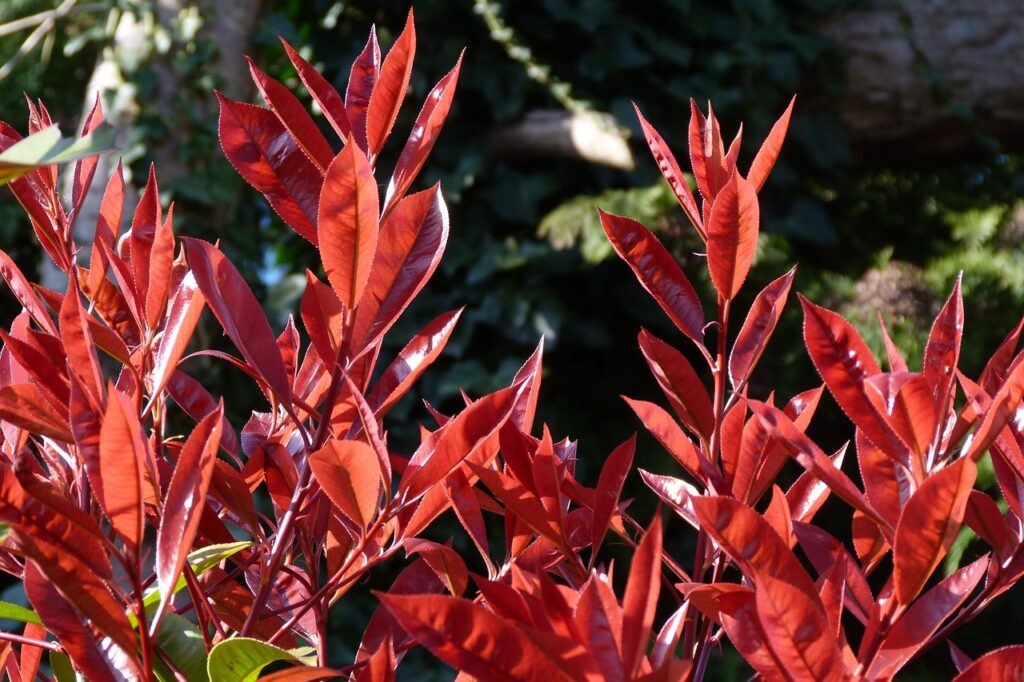
Soil Type
Red Robins like a reasonably rich soil with a good amount of nutrients.
Their root system is fairly shallow so they do not like soil that is too free draining, as this can drain away the nutrients they need out of reach.
Our soil is very sandy and I have found that I need to add a decent amount of organic matter.
Some drainage is good however, as Red Robins do not like to sit in waterlogged soil.
Soils with not enough nutrients or incorrect drainage can stress the plant causing leaf discolouration and loss.
How to fix:
- Red Robins should do OK in most soils but some may need additional material to get the right mix.
- If your soil is very sandy or poor then add a good amount of compost.
- If your soil is heavy clay that compacts, you will need to work in some grit for drainage.
- Loamy soils seem to be the best fit.
- Mulch in spring and autumn/early winter to enrich the soil.
Lack Of Magnesium
Following on from the section above, Red Robins are hungry plants that like a lot of nutrients.
One particular mineral that they need is magnesium.
Lack of magnesium can cause purple spots on the leaves, and a general die back of older leaves.
This can be especially evident in sandy soils as the mineral can drain away out of the reach of the root system.
I have had this problem with my Red Robin.
How to fix:
- Fertilise with a general feed that contains blood, fish and bone material every couple of months in the growing season.
- You can also give the plant magnesium sulfate in the form of Epsom salts, mixed as per the packet.
- This is usually a tablespoon per gallon of water, applied once every two months if the Red Robin is showing signs of magnesium deficiency.
- Make sure your soil is enriched with extra organic matter if sandy or poor, to help the nutrients stay in reach of the roots.
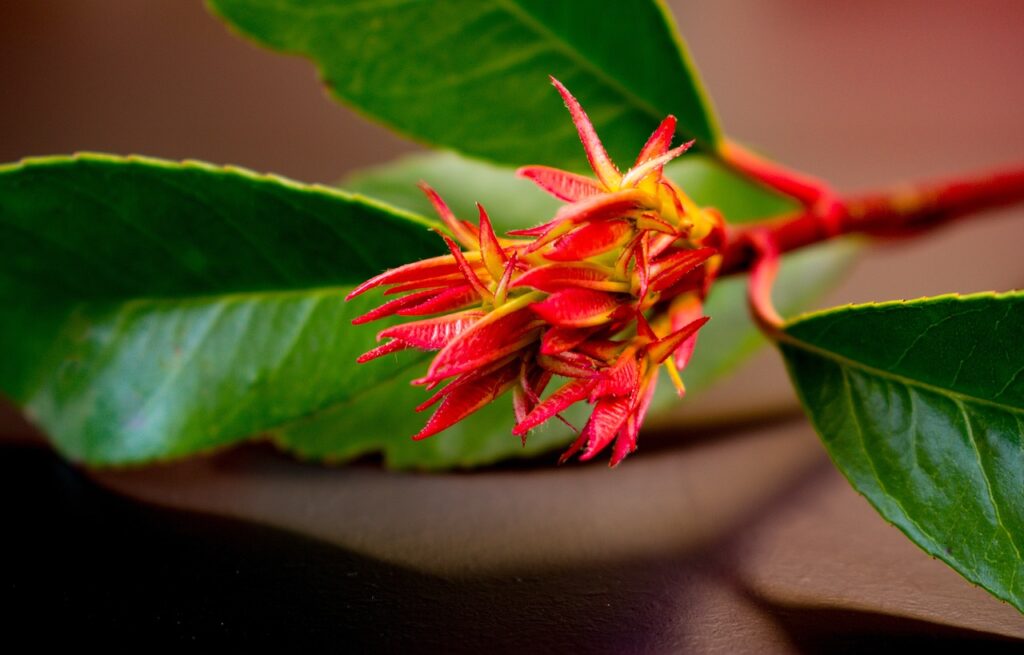
Too Much Water
As mentioned above, Red Robins don’t like overly wet conditions or water saturated soil.
This will cause the roots to become waterlogged which interferes with the intake of water.
This can then lead to leaf drop.
How to fix:
- When planting a Photinia Red Robin, choose a location with reasonable drainage.
- Water young or newly transplanted Red Robins, however established plants should be able to find their own water.
- The exception to this is during very dry weather, when extra irrigation can be provided.
Fungus – Leaf Spot And Armillaria Root Rot (Honey Fungus)
Red Robin plants can be susceptible to two main types of fungus.
The first is Leaf Spot which shows as black or dark red spots forming on the leaves, which is followed by leaf drop.
It is caused by moist conditions and seems to occur most in shaded areas with poor air flow.
How to fix Leaf Spot:
- If you see the signs on your Red Robin foliage, you can remove the affected leaves and dispose (not on the compost heap).
- Make sure to clear fallen leaves and debris from around the base of the plant.
- This will improve ventilation and reduce the number of airborne spores.
- Mulch around the base of the plant (leaving a space immediately around the stem).
- This will create a barrier between any spores on the ground and the plant.
- Promote your Red Robin’s general health by providing the plant with lots of sunshine and soil nutrients.
- You will often find that a healthy plant can withstand a little Leaf Spot, and new unaffected growth will come through the next spring.
How to fix Armillaria Root Rot (Honey Fungus)
- This fungus can be identified by rotting roots, cracking bark at ground level, a mushroomy odour and a white fungal substance forming between the bark and trunk.
- Honey coloured mushrooms can sometimes appear around the base in autumn.
- Foliage can be pale, stunted and prone to leaf drop.
- Unfortunately this is a difficult fungus to treat and often prevention is better than a cure.
- Again promote your plant’s wellbeing to decrease the chances of succumbing to this disease.
- Avoid overwatering, and if your soil is heavy clay add some grit or sand to improve drainage.
- If you see the advanced signs above it may be better to remove the plant entirely and dispose (not in the compost heap).
- Include all roots and dig up the surrounding soil to break up the underground rhizomorphs.
- Consider growing just grass in this area to allow it to recover.
Final Thoughts
Photinia Red Robin is a colourful addition to the garden in all seasons.
They can also make good hedging plants along with Hornbeam, Privet and Laurel.
Keeping those green and red leaves glossy, healthy and abundant is vital to get the best display.
If you are having any issues not covered here then please send me a message and I will do my best to help.
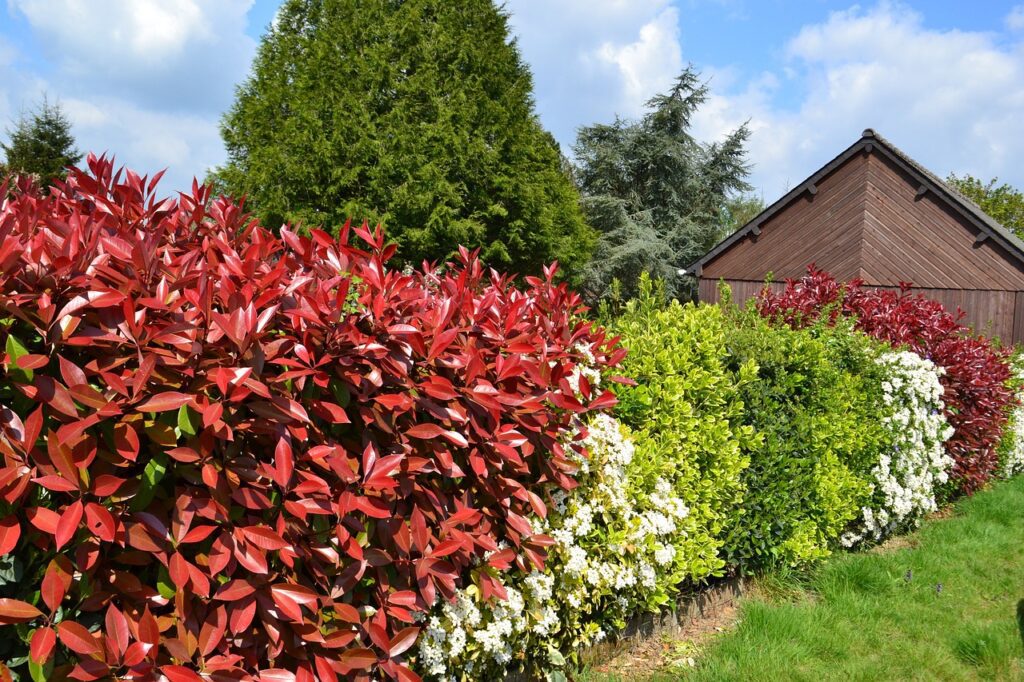

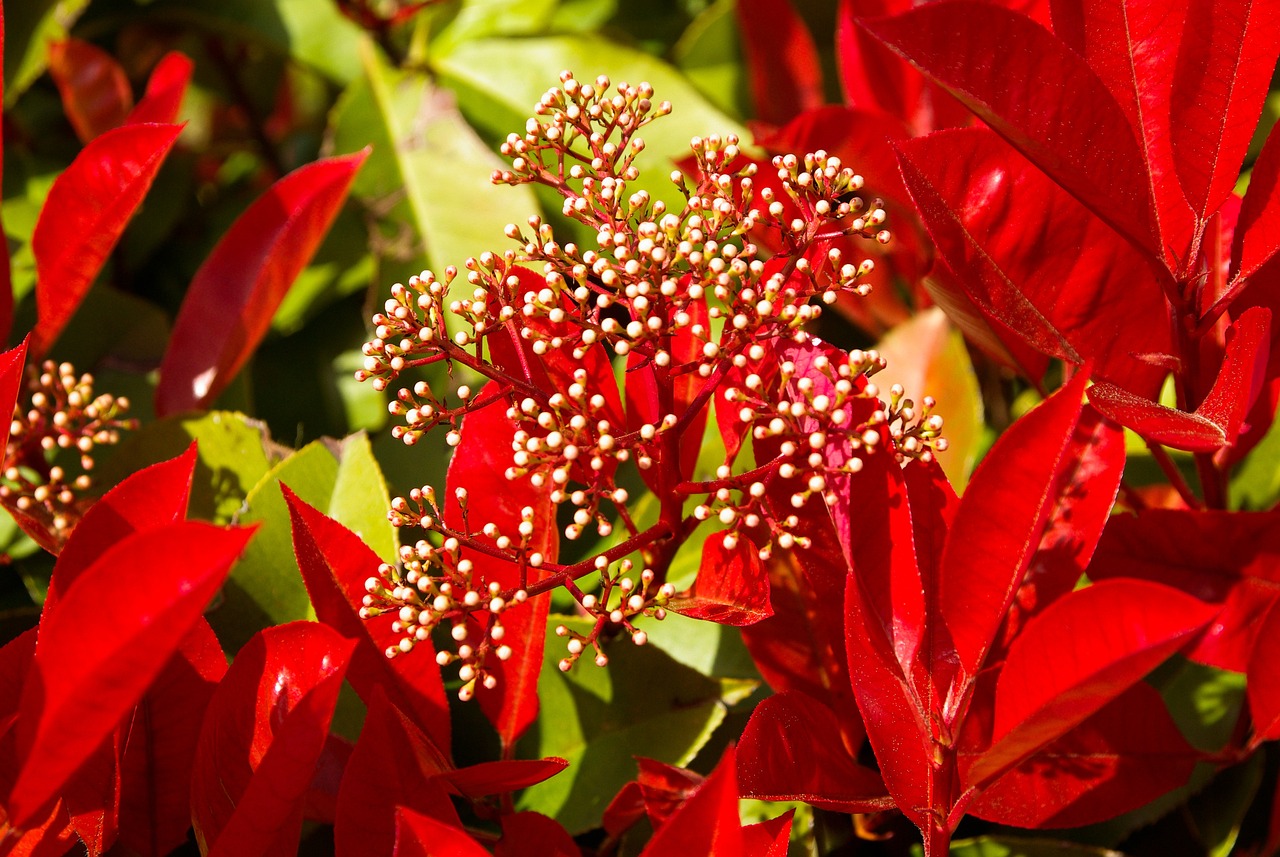
I have a Photiena hedge that is apx 8 feet thick 10 feet high and it runs apx 400 feet. Enclosing my inground pool area and back yard. This winter I noticed all the leaves are bare from ground level up apx 4 feet almost in a straight line. But only on one side the west side. I trim and shape this hedge every spring. Hedge was planted in 1996 Many birds have made this their home. I live in Northern Ca. Clearlake. Hot summers cold winters. Reading about using a funguside and adding magnesium. This hedge gets plenty of sun and tommorow I will do some more investigating. I think it might be the cold, since October 1 2022 up to today 2-1-23 we have had 40 inches of rain. This winter more snow than usual. We are at 2,000 feet elevation.Snow that stayed on ground for like 9 days. A load of weight on hedge. Hope to send u some photos thankyou Lex Benjamin 707 349-5913
Dear Lex,
Thank you for your query. As the leaf drop is only on the west side this would indicate some sort of climate effect, otherwise all of the hedge would be affected. Is the west side more exposed to rain / wind / snow? If so, and if as you say the weather has been colder and wetter than normal, then likely the prolonged exposure has caused the leaf drop. If that is the case then the leaves should return when the weather warms up and dries out. You can encourage bushier growth when this happens by waiting for the red leaves to turn green and then pruning lightly. Let me know how you get on.
All the best,
Sue X
Hi Sue, we have 4 red robin trees along the back of our garden, they are all about 10 ft high, early this year one of them started dropping it leaves and they have now all dropped, the other 3 are very healthy, any suggestions 🤷♂️
Hi Peter,
I’m sorry to hear that – I’ll just ask a few questions if that’s ok: Is there anything significantly different about that 4th tree that is struggling – ie is it in a dip that collects more water than the other 3, or is it more shaded than the other 3? What did the leaves look like when they fell – were they brown/green/yellow or mottled/spotted?
Thank you,
Sue